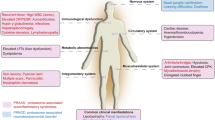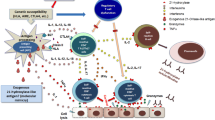Summary
The mode of genetic transmission of gout and increased activity of phosphoribosylpyrophosphate synthetase (PRPPS) was studied in one family. Among 15 members of Family F, two male members had gout and had PRPPS activity of erythrocyte lysates three times higher than normal subjects. Five female members had activity 2.5 times higher than normal. The difference between the activities of male and female affected members was statistically significant (P<0.05). To examine the genetic trait of this abnormal PRPPS, the incorporation of 3H-adenine into erythrocytes or lymphocytes was studied using autoradiography. The number of grains which show the uptake of labeled adenine into cells revealed a normal distribution pattern in two normal persons and in two male patients, and a mixed pattern of the two cell populations in two female affected members. These results suggested mosaicism in female members and X-linked dominant transmission of this trait. Thermal inactivation of PRPPS of an affected female was intermediate between that from a normal subject and that from the affected males. This result showed the heterogeneity of the PRPPS from the hemolysate of an affected famale. The genotype of PRPPS on the X-chromosome was assumed and the lod score between PRPPS and Xg was also estimated. From these findings and electrophoretical study, it was suggested that the abnormal enzyme was a mutant enzyme transmitted in an X-linked dominant trait, and that the mutation occurred on the structural gene of the PRPPS.
Similar content being viewed by others
References
Akaoka I, Fujimori S, Kamatani N, Takeuchi F, Yano E, Nishida Y, Hashimoto A, Horiuchi Y (to be published) A gouty family with increased phosphoribosylpyrophosphate synthetase activity. J. Rheumatol
Becker MA, Meyer LJ, Wood AW, Seegmiller JE (1973a) Purine overproduction in man associated with increased phosphoribosylpyrophosphate synthetase activity. Science 179:1123–1126
Becker MA, Meyer LJ, Seegmiller JE (1973b) Gout with purine overproduction due to increased phosphoribosylpyrophosphate synthetase activity. Am J Med 55:232–242
Becker MA, Kostel PJ, Meyer LJ, Seegmiller JE (1973c) Human phosphoribosylpyrophosphate synthetase. Increased enzyme specific activity in a family with gout and excessive purine synthesis. Proc Natl Acad Sci USA 70:2749–2752
Becker MA, Seegmiller JE (1975) Recent advances in the identification of enzyme abnormality underlying excessive purine synthesis in man. Arthritis Rheum 18:687–694
Becker MA, Kostel PJ, Meyer LJ (1975) Human phosphoribosylpyrophosphate synthetase. Comparison of purified normal and mutant enzymes. J Biol Chem 250:6822–6830
Becker MA, Raivio KO, Seegmiller JE (1979a) Synthesis of phosphoribosylpyrophosphate in mammalian cells. Adv Enzymol 49:281–306
Becker MA, Yen RCK, Itkin P, Goss SJ, Seegmiller JE, Bakay B (1979b) Regional localization of the gene for human phosphoribosylpyrophosphate synthetase on the X chromosome. Science 203:1016–1019
Becker MA, Raivio KO, Bakay B, Adams WB, Nyhan WL (1980) Variant human phosphoribosylpyrophosphate synthetase altered in regulatory and catalytic functions. J Clin Invest 65:109–120
Böyum A (1968) Separation of leucocytes from blood and bone marrow. Scand J Clin Lab Invest 21: Suppl 97
DeVries A, Sperling O (1973) Familial gouty malignant uric acid lithiasis due to mutant phosphoribosylpyrophosphate synthetase. Urologe A12:153–157
Emmerson BI, Gordon RB, Johnson LA (1977) Hypoxanthine-guanine phosphoribosyltransferase activity in individual erythrocytes. In: Elliott K, Fitzsimons W (eds) Purine and pyrimidine metabolism. North-Holland Publishing, New York, p 97
Folin O, Wu H (1919) A system of blood analysis. J Biol Chem 38: 81–110
Fox IH, Kelley WN (1971) Human phosphoribosylpyrophosphate synthetase. Distribution, purification, and properties. J Biol Chem 246:5739–5748
Genners WD, Von Norman JD (1975) Quantitation of free, total and antibody-bound insulin in insulin-treated diabetics. Clin Chem 21: 873–879
Henderson JF, Rosenbloom FM, Kelley WN, Seegmiller JE (1968) Variations in purine metabolism of cultured skin fibroblasts from patients with gout. J Clin Invest 47:1511–1516
Hershko A, Razin A, Mager J (1969) Regulation of the synthesis of 5-phosphoribosyl-1-pyrophosphate in intact red blood cells and in cell-free preparations. Biochim Biophys Acta 184:64–76
Hopkinson DA, Cook PJL, Harris H (1969) Further data on the adenosine deaminase (ADA) polymorphism and a report of a new phenotype. Ann Hum Genet 32:361–366
Karman A, Wroblewski F, Ladue S (1955) Transaminase activity in human blood. J Clin Invest 34:126–131
Kelley WN, Rosenbloom FM, Henderson JF, Seegmiller JE (1967) A specific enzyme defect in gout associated with overproduction of uric acid. Proc Natl Acad Sci USA 57:1735–1739
Leon LP, Stasiw RO (1976) Performance of automated enzymatic cholesterol on SMA 12/60 and autoanalyzer-II instruments. Clin Chem 22:1220 (Abstract)
Levitan M, Montagu A (1971) Textbook of human genetics. Oxford University Press, New York, p 388
Liddle L, Seegmiller JE, Lasler L (1959) The enzymatic spectrophotometric method for determination of uric acid. J Lab Clin Med 54: 903–913
Lowry OH, Rosebrough NJ, Farr AL, Randall RJ (1951) Protein measurement with the Folin phenol reagent. J Biol Chem 193: 265–275
Lyon MF (1961) Gene action in the X-chromosome of the mouse (Mus musculus L.). Nature 190:372–373
Miwa S, Fujii N, Matsumoto N, Nakatsuji T, Oda T, Asano H, Asano S, Miura Y (1978) A case of red cell adenosine deaminase overproduction associated with hereditary hemolytic anemia found in Japan. Am J Hematol 5:107–115
Pearson PL, Witterland WF, Meesakhan P, DeWitt J, Bobrow M (1977) Reinvestigation of two X1 autosome translocation segregations in cell hybrids. In: Bergsma D (ed) Human gene mapping, 4th edn. Karger, Basel, p 534
Reem GH (1975) Phosphoribosylpyrophosphate overproduction. A new metabolic abnormality in the Lesch-Nyhan syndrome. Science 190: 1098–1099
Schimke RT, Kaufman RJ, Alt FW, Kellems RF (1978) Gene amplification and drug resistance in cultured murine cells. Science 202: 1051–1055
Sperling O, Boer P, Persky-Brosh S, Kanarek E, DeVries A (1972a) Altered kinetic property of erythrocyte phosphoribosylpyrophosphate synthetase in excessive purine production. Rev Eur Etud Clin Biol XVII:703–706
Sperling O, Eilam G, Persky-Brosh S, DeVries A (1972b) Simpler method for the determination of 5-phosphoribosyl-1-pyrophosphate in red blood cells. J Lab Clin Med 79:1021–1026
Stoeckler JD, Agarwal RP, Agarwal KC, Parks RE Jr (1978) Purine nucleoside phosphorylase from human erythrocytes. Methods Enzymol 51:530–538
Thomas CB, Arnold WJ, Kelley WN (1973) Human adenine phosphoribosyltransferase. Purification, subunit structure, and substrate specificity. J Biol Chem 248:2529–2535
Tyler B, Deleo AB, Magasanik B (1974) Activation of transcription of hut DNA by glutamine synthetase. Proc Natl Acad Sci USA 71: 225–229
Valentine WN, Paglia DE, Tartaglia AP, Gilsanz F (1977) Hereditary hemolytic anemia with increased red cell adenosine deaminase (45- to 70-fold) and decreased adenosine triphosphate. Science 195:783–785
Wood AW, Becker MA, Seegmiller JE (1973) Purine nucleotide synthesis in lymphoblasts cultured from normal subjects and patient with the Lesch-Nyhan syndrome. Biochem Genet 9:261–274
Wyngaarden JB, Kelley WN (1976) Gout and hyperuricemia. Grune and Stratton, New York, p 38, p 301
Yen RCK, Adams WB, Lazar C, Becker MA (1978) Evidence for X-linkage of human phosphoribosylpyrophosphate synthesis. Proc Natl Acad Sci USA 75:482–485
Zoref E, DeVries A, Sperling O (1977) Evidence for X-linkage of phosphoribosylpyrophosphate synthetase in man. Hum Hered 27: 73–80
Author information
Authors and Affiliations
Rights and permissions
About this article
Cite this article
Takeuchi, F., Hanaoka, F., Yano, E. et al. The mode of genetic transmission of a gouty family with increased phosphoribosylpyrophosphate synthetase activity. Hum Genet 58, 322–330 (1981). https://doi.org/10.1007/BF00294932
Received:
Revised:
Issue Date:
DOI: https://doi.org/10.1007/BF00294932




